Odds & Ends: Hour of Devastation, Part 2
Last week I started answering your questions about Hour of Devastation. You had so many good ones, I had to keep on answering them.

From day one, we knew Zombie tribal was going to be a part of the block. Cat tribal also happened very early in design. The rest of the tribal cards just happened along the way. I don't remember us particularly thinking about either Naga tribal or Jackal tribal, but I also wouldn't be surprised if one popped up in design or early development and then got cut as the set evolved.
My social media accounts have really been hammering home recently how much players love tribal, so I think doing more tribal themes and one-of tribal cards is something for us to be thinking about. We already tend to do some each block, but I've been wondering if our levels are just too low as a baseline. I'm very curious what you all think about our level of tribal support and whether or not we're supposed to be ramping up—and if so, to what extent.
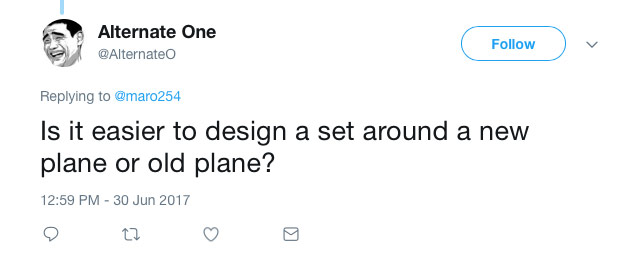
Each has its challenges. The challenge of a new plane is that you have to figure out everything from scratch. What kind of creatures are here? What kind of gameplay? What's the focus mechanically? What's the emotional feel we're trying to get out of the world? A blank slate can be fun, but it's also intimidating. Amonkhet, for example, allowed us to explore an Egyptian-inspired world and also let us dig a bit deeper into Nicol Bolas's psyche. It was fun seeing where these new inspirations took us, but it was also frustrating. New worlds create a lot more dead ends and require more rework and polishing than return sets. Part of figuring out an identity is trying various things and slowly coalescing as you iterate.
The challenge of an old plane is that it comes with a lot of baggage. There are tons of expectations that have to be met and you have the specter of previous visits hanging over you. You have to deliver the world the players remember while still finding new ways to innovate. The trickiest part is that different players enjoyed different aspects of the old plane, so there's no way to capture what everyone wants in a return. Also, if you change too much, then players are unhappy that the world they love is not the same as they remember it. It's a tricky balance.
The question though is which one is harder. If I had to pick one, I guess I'd pick new worlds. While old worlds have a lot of issues, they at least come with a template of success and failures to help guide you.
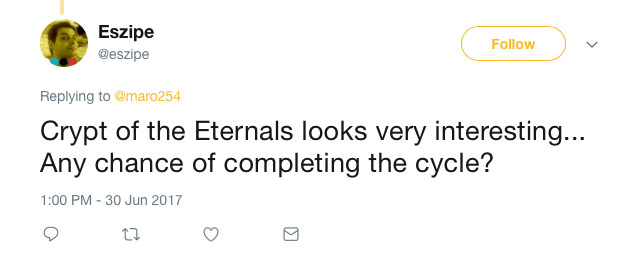
Interesting question. In a vacuum, my guess would be that yes, we're planning to do this cycle some time in the future in a set that revolves around arcs (three colors that appears in a row around the color wheel). It's clean and practical. The one thing that gives me pause though is the name. It's pretty world/story specific. Okay, my guess is yes, we'll eventually see the cycle, but the blue-black-red one might get renamed.
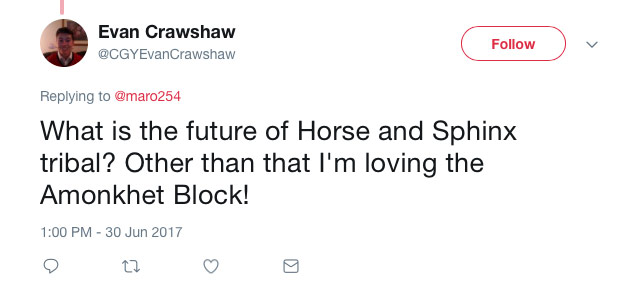
Tribal support falls into three categories for me.
First is significant support. These are tribes that we routinely support with tribal rewards. The best examples of these are what I call characteristic tribes, race creature types that show up pretty regularly in their respective color (Humans, Merfolk, Zombies, Vampires, Goblins, and Elves—yes black has two). There are also some class creature types (such as Soldiers, Warriors, Wizards, Shaman, and Clerics) that we support often. This first category houses creature types that we plan to support on an ongoing basis, something that I would expect to show up every three to four years, even if only on a single card.
Second is occasional support. These are things like are iconic tribes (Angels, Sphinxes, Demons, Dragons, and Hydras) that show up at rare as ideals of the color. It's also tribes that we print in just enough volume that we show tribal support now and then (things like Minotaurs, Snakes, and Cats). This second category contains creature types we plan to support ongoing, but at a lower level. These I would expect to show up every seven to eight years, sometimes on just a single card.
Third is sporadic support. These are creature types that mostly don't get tribal rewards. We might throw them a bone every once in a rare while, but it's not something to expect.
Amonkhet block had Zombie, Cat, Sphinx, and Horse tribal. Zombies are in the first category. Cat and Sphinx are in the second (although the popularity of Cats could potentially get it into the first category one day). Horses are in the third category.
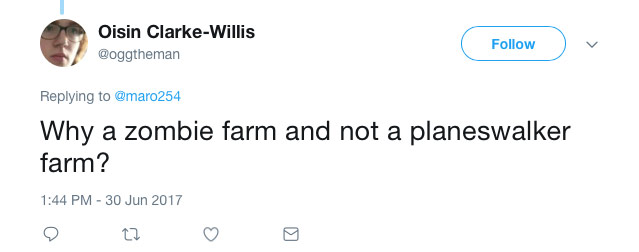
Because Zombies are way easier to make than Planeswalkers. Anyone can be turned into a Zombie. Only a person with a spark can become a Planeswalker. Here's my little play about what would happen if Bolas tried a Planeswalker farm rather than a Zombie farm:
Nicol Bolas: I'm back!
The Scarab God: It's great to see you again. Can't believe it's been 60 years.
Nicol Bolas: How's our little project going?
The Scarab God: Excellent! We are ahead of schedule.
Nicol Bolas: That's good to hear. Can I see my army?
The Scarab God: Absolutely, walk this way.
Nicol Bolas follows The Scarab God into a room.
Nicol Bolas: This is it?
The Scarab God: Yes!
Nicol Bolas: Two Planeswalkers? My army is two Planeswalkers?
The Scarab God: The average for our population so far would be 1.3. The fact that we have two is super lucky.
Nicol Bolas: How are my master plans going to work with two Planeswalkers? The four of us in this room couldn't even form a basketball team!
The Scarab God: If your plans involve basketball, we could ask The Locust God to help us. If flying isn't illegal, he'd be great at dunking.
Nicol Bolas: Two Planeswalkers?! Two!
Samut: If you're going to keep yelling, I'm out of here.
And scene.
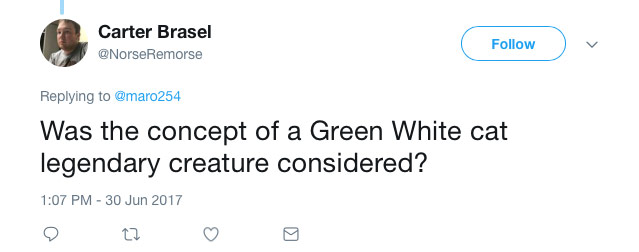
No, for two reasons. One, while I had high hopes for the Cat tribal in the block, it was done more speculatively than anything else. It was never intended as a major theme, just something light that some players could build around. Two, we tend to build our legendary creatures from the story, and Cats just aren't a big part of it. They were much more for Egyptian-inspired flavor than anything else. Now that we've made some Cat tribal cards and seen the extremely positive reaction, that increases the possibility that we'll make a green-white legendary Cat in the future.
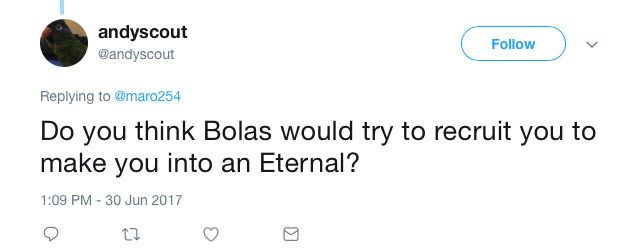
I would make a horrible Eternal. First, I'm pretty small. Have you seen this video?
Bolas would recruit one of us, and it isn't the man in flannel. Unless there's some need to fit in small spaces, I'm pretty sure I don't meet the height requirement.
Second, I can't fight. Physically speaking. I can debate. I'm not bad at arguing, but I don't think that's what Bolas is looking for in a Zombie soldier.
Third, I don't think I'd fall for the whole Trial thing. I can spend years reaching my physical peak so that I can battle to the death and get killed even if I win? That's worse odds than the Hunger Games, so no thank you. I'll keep somewhat fit, but I'm going to limit my exercise to things where I probably won't end up dead.
Fourth, I like to believe in a time of crisis I'd spark and then be far away hopefully on a peaceful plane; you know, the kind of place we'd never visit.
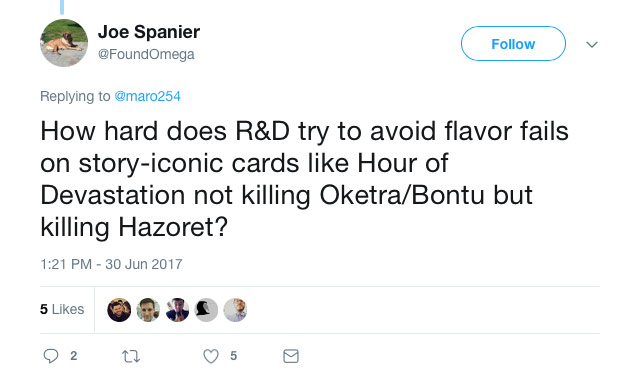
The Scorpion God killed Oketra and Bontu before the Hour of Devastation ever occurred, so I'm calling this story acceptable. Hazoret, um, faked her death so Bolas wouldn't know.
We do try to think about interactions between cards as they relate to story, but it isn't a non-negotiable that gameplay always 100% matches how the story plays out. We do it where we can, but we've decided good gameplay gets to occasional trump matching every aspect of the story.
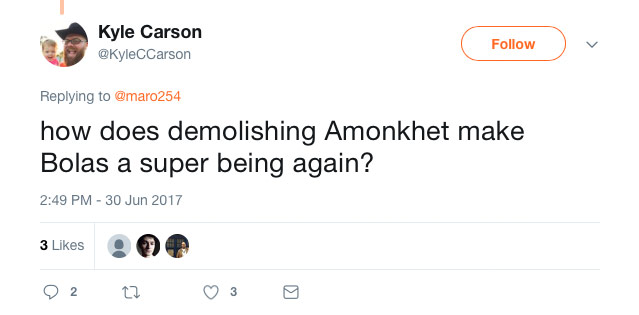
It doesn't. So what exactly is Bolas up to? That's a fine question. Something I hope all of you discuss. Part of our commitment to having an ongoing story is having a much tighter payoff timeline. In Magic story of old, we might start a thread that took over a decade to resolve. We're trying not to stretch things out quite as far. Bolas has a plan and you all will learn of it in future sets—and not ones ten years from now.

When the Council of Colors looks at cards to see if they are acceptable within the color pie, they give each card a grade it from 1 to 4. A grade of 1 means a card is within the color's normal slice of the color pie. A 2 means it's a bit of a stretch but it makes sense in the set that it's in. A 3 means it's a bit of a stretch and doesn't fit within the set it's in. Finally, 4 means it's clearly not in that color's slice of the color pie. For shorthand, 1 is "normal," 2 is "an acceptable bend," 3 is "an unacceptable bend," and 4 is "a break."
Hour of Eternity is a great example of the separation between a 2 and a 3, or an acceptable and unacceptable bend. Blue traditionally does not mess with creatures in graveyards. Blue usually gets back instants and/or sorceries and artifacts on occasion. When we made embalm, our solution to solve memory and counter issues was to have the card make a creature token that's a copy of the creature card. Cloning is pretty squarely in blue, so it pushed embalm more toward blue.
In Hour of Devastation, we tweaked embalm with eternalize. Also, we tied the Eternal army to Bolas's three colors (blue, black, and red). Hour of Eternity essentially eternalizes all the creature cards in your graveyard. Eternalize is partly blue. Some of the Eternals are blue. Cloning the dead is kind of blue. In this place at this time, the mechanic made sense in blue, but if we tried to make this same spell in another set, it very well could shift from a 2 to a 3 and not be printable.
So yes, this is blue messing in black space, but in a way that, for this set, makes sense.
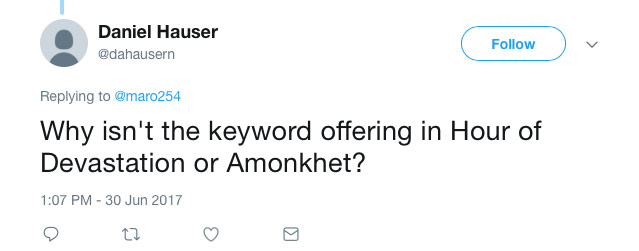
One of the things we always do early in design is make a list of any reprint mechanics we could use in the set. On average, we tend to bring back one mechanic per block, but are willing to bring back more if they make sense. I don't believe offering made our short list of mechanics to bring back. Here's why:
1. The Flavor Is Off
Offering implies that you sacrifice others for your own gain. The deviousness of Bolas's plan is that he got the people of Naktamun to voluntarily sacrifice themselves.
2. It Didn't Have the Right Mechanic Support
Offering is a tribal mechanic. Amonkhet block has small tribal elements but isn't a tribal block. The only creature type with enough support to use offering would be Zombies, and once again, the Zombies were the end state of what Bolas wanted, not the thing he wanted to sacrifice.
3. It Isn't Particularly Popular
An important part of bringing back mechanics is making sure we're returning to the game something players want to see come back. Offering was not particularly well received when we first used it back in Betrayers of Kamigawa, which makes us less likely to bring it back.
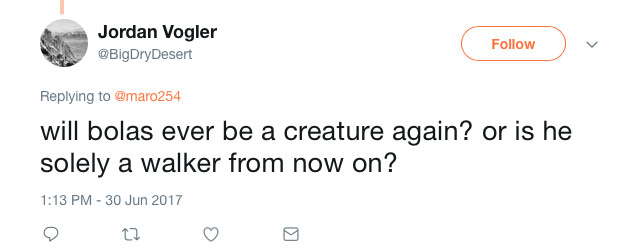
Our rule on legendary creature cards for Planeswalkers is that we only use them to represent a Planeswalker prior to their spark igniting or after they've lost their spark, basically when they're not a Planeswalker. There are a few exceptions, like Xenagos when he ascended to godhood, but in general, if a character is a Planeswalker, we show them in card-form as a planeswalker.
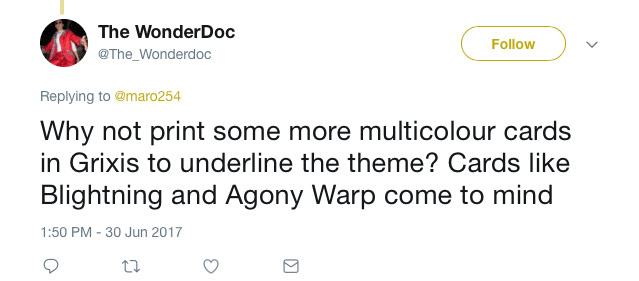
We've messed around with color imbalances before (the sets Torment and Judgment being the biggest examples). What we have found is that they cause more problems than the good they do, so we try very hard to keep our colors mostly in balance. This was Bolas's set, so we wanted a little nod to his colors (blue, black, and red), but we were very careful to keep it in check. The three insectoid Gods seemed to be the best place to push this, so that is where we put our emphasis of Bolas's influence.
The Hour Is Nigh
Sadly, it's time to wrap up for today. I hope you enjoyed all the questions from these past two weeks. As always, I would love to hear your feedback, be it on a particular answer or on a larger issue of the set. You can email me or talk to me through any of my social media accounts (Twitter, Tumblr, Google+, and Instagram).
Join me next week when the cat will be out of the bag.
Until then, may you have fun in Bolas's shoes, um, I mean wings.
#456: Mechanical Color Pie
#456: Mechanical Color Pie
35:35
A few months ago, I wrote an article where I spelled out what colors did what in the color pie. In this podcast, I talk all about the making of this article and why the mechanical color pie is so important.
#457: Color Pie: Dealing with Creatures
#457: Color Pie: Dealing with Creatures
46:57
This is my first mechanical color pie podcast where I go in depth on one mechanical aspect. For my maiden voyage, I chose to talk about how the five colors handle creatures.
- Episode 455 Complexity (30.3 MB)
- Episode 454 Flashback (27.9 MB)
- Episode 453 Amonkhet, Part 2 (24.9 MB)

